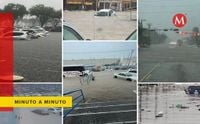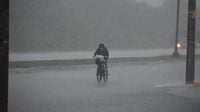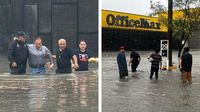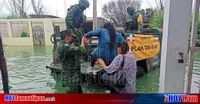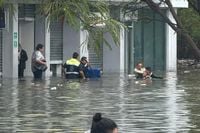Severe flooding struck Reynosa, Tamaulipas, on Thursday, March 27, 2025, as intense rains overwhelmed the city, collapsing roads and affecting hundreds of motorists, pedestrians, and homes. The downpour began around 4:00 AM, resulting in water accumulations of up to six inches in various areas. Later in the afternoon, another wave of rain exacerbated the situation, turning main avenues into rivers and halting mobility across the city, including in industrial parks and access points to maquiladoras.
Residents in neighborhoods such as Ernesto Zedillo, Juan Escutia, Villarreal Florida, and Unidad Obrera reported that water began to seep into their homes, prompting them to improvise barriers to prevent further damage. In the industrial park housing the Corning maquiladora, vehicles were submerged in the parking lots, trapping some employees inside. Hospitals like IMSS and ISSSTE also experienced water leaks, raising concerns among patients and medical staff.
Access to the Reynosa-Hidalgo international bridge became difficult due to flooding, hindering the daily commute of hundreds of students traveling to Texas for classes. Despite the SENTRI line, traffic at the border crossing moved slowly because of standing water and reduced lanes. Drivers found themselves stranded in flooded areas, particularly on avenues like Vista Hermosa and the exit to San Fernando, while underpasses were closed due to high water levels.
The hazardous conditions on the streets led to multiple traffic accidents, attributed to wet pavement, poor visibility, and speeding. Authorities urged the public to exercise caution and avoid flooded areas. In response to the crisis, the Industrial Autonomous Union of Maquiladoras of Reynosa requested a suspension of work to ensure the safety of workers.
As the situation unfolded, the Mexican Army activated the DNIII plan to assist those affected by the floods. Military personnel collaborated with the state government to provide support, using mobile units to evacuate people from their homes and transport them to safe shelters. The Army's efforts were part of a coordinated response to the disasters caused by the severe weather.
Earlier in the day, Civil Protection Tamaulipas issued a climate alert for Reynosa due to the ongoing storm, which included intense rains, wind gusts reaching up to 70 km/h, and the possibility of hail. The rains that began on the night of March 26 had already caused significant damage and flooding across various parts of the city.
The Secretariat of National Defense also activated the DN-III plan to provide assistance to the affected civilian population. The government of Tamaulipas, through the State Coordination of Civil Protection and the State Guard, deployed personnel to help those in need, particularly in Reynosa and Miguel Alemán, where the flooding was most severe.
Reports indicated that while there were no injuries, dozens of vehicles had been swept away by the strong currents in Reynosa. The government and military coordinated rescue operations, focusing on those stranded in their vehicles due to the rising water levels. The State Coordination of Civil Protection sent an aid brigade to the area to support these efforts, while the National Guard worked alongside state authorities to address the affected urban areas.
As the day progressed, forecasts indicated that a new storm system was moving into Reynosa and Río Bravo, with expectations of moderate to heavy rainfall that could worsen the ongoing flooding. Accumulated precipitation in the region was nearing 300 mm in less than 24 hours, raising alarms about the potential for further damage.
Authorities in Reynosa continued to carry out rescue operations as residents reported needing boats to escape their homes. Civil Protection and Firefighters were on high alert, conducting tours of neighborhoods that could be affected by the severe weather. They warned of the elevated risk of flooding in low-lying areas, falling trees, and power outages as the storm system brought locally intense rain and electrical storms.
Videos shared on social media illustrated the severity of the flooding, showing passenger trucks being swept away and individuals trapped in their cars. Primary Public Services in Reynosa utilized dump trucks and backhoes to assist in rescue efforts, while residents called for boat support to evacuate from ranches that had also suffered from the rainfall.
City authorities urged residents to take shelter and heed warnings about the dangerous weather conditions. The community remained on high alert as rain continued to fall, with no immediate relief in sight.
In summary, the flooding in Reynosa has prompted a comprehensive emergency response from local and federal authorities, with ongoing efforts to assist those affected by the crisis. As the rain persists, the situation remains critical, and residents are advised to stay informed and prioritize their safety.
